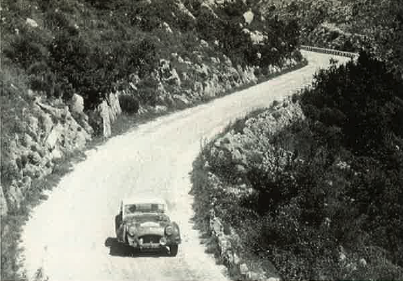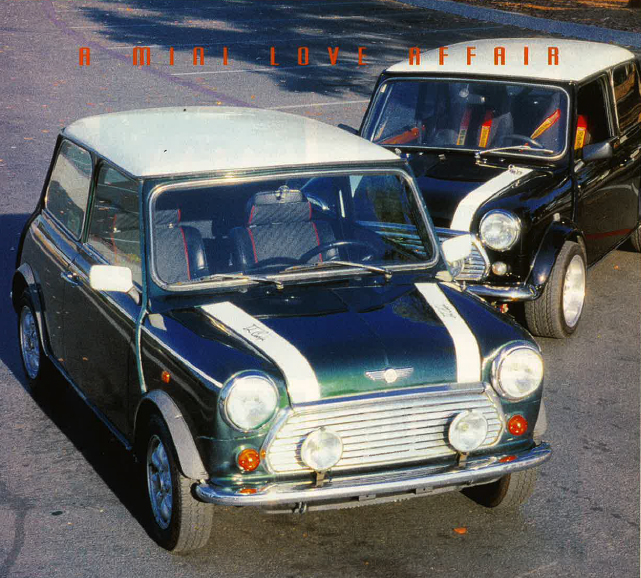By Paul Richardson
The international rallies in Europe in the ’50s were run over some of the most testing routes imaginable, especially the Criterium Des Alpes, commonly known as The Alpine. As its name implies, the rally was essentially contested over the high Alpine passes of central Europe and was generally regarded as the toughest test of endurance for any car or crew. But competitor, press, and spectator opinion labeled the 1954 event as the toughest and most dangerous Alpine to date.
It is well known that the Alpine rally was feared by many crews simply because the Alpine passes were so dangerous. It was also a policy of the Alpine organizers to include the highest and toughest of those passes if they were not impassable by snow or avalanche. The passes had steep climbs and descents, which in those days could only be described as loose, surfaced, single-lane cart tracks. At altitude they were covered in snow, often on top of sheet ice, and at the lower levels, icy roads could be made worse by rain. Many of the passes were hewn from the side of mountains where the climbs and descents had solid rock on one side and no effective guard rails whatsoever on their outer edge. One mistake could result in a drop of thousands of feet off the side. Just to make things more interesting for crews, the route was organized so that many of the highest passes were met at night.
In 1954, three works Triumph TR2s took part in the Alpine, which was the first international rally in which a works team was entered. The three-car team consisted of team leaders Ken Richardson and co-driver Kit Heathcote, who became his P.A., Lyndon Mills and U.K. Sales Manager of the company, Jimmy Ray, Robbie Slotemaker, and Maurice Gatsonides.
The rally started on July 8 in Marseilles in southern France. The three-car team left the starting ramp in late afternoon for their first Alpine adventure. The route ran east towards the first checkpoint in the French Alps, which was reached in darkness. Cars were refueled there for the daunting task of driving four major Alpine passes in the dead of night. The Col D’Allos (7,350 ft.), Col de Vars (6,926 ft.) and the Col D’Izoard (7,746 ft.) were successfully negotiated and the three TRs pressed on to Briancon and over the border into Italy via the Col de Montgenevre (6,070 ft.). The remaining few hours of darkness were then spent driving through the Lombardy plain towards Bergamo in readiness to tackle the single-track roads leading up into the mountains towards the Vivione pass.
It was in a narrow section of the Vivione that a puncture put Richardson and Heathcote out of the running for a coveted Coupe des Alpes which was awarded for any car completing the rally without losing points. The puncture caused a time penalty at the next checkpoint, where they arrived one minute and 54 seconds late. Having had no sleep, crews spent the second day’s hard driving heading for the first night stop at St. Moritz, Switzerland, which was the end of the first stage. All the works TRs arrived safely and in good time. At St. Moritz, the organizers rerouted the second stage of the rally due to an avalanche which had totally blocked the Stelvio pass. Major flood reports caused a second route change. Once resumed, the rally passed from St. Moritz into Italy, back into Switzerland, and then Austria and Germany.
From Germany, the route took competitors back to Austria through Innsbruck and into Italy via the notorious Brenner Pass. Finally, competitors arrived at Cortina D’Ampesso for the end of the second stage.
The third stage was essentially a 190-mile road race in and around the Dolomite Mountains with the start and finish at Cortina. “The day dawned with perfect conditions, and for the first 30 miles or so we encountered some very steep ascents which held everyone’s average speed well down, so much so that it appeared we’d never make up the lost time,” Heathcote said. “But it turned out later on that there were some sections where much higher speeds could be achieved. This, coupled with Ken’s superb driving, got us to the finish back in Cortina with 28 minutes in hand. By achieving this performance, we had overtaken all the cars that had started before us and, having averaged 50 mph for the 190-mile circuit, we made our second fastest time of the day. Thus, before the halfway mark, we became the leading car in the rally.”
The final 24-hour stage of the rally ran from Cortina to Cannes on the Mediterranean coastline of France. This section took in the Stelvio pass, which was cleared for the return run. Competitors drove 9,045 ft. of what was one of the highest roads in Europe. The Stelvio pass zigzags up mountainsides in a series of short straights connected by hairpin bends. The majority of the road surface was loose shale with reinforced concrete (the only hard surface) on the hairpin bends where grip underbraking and acceleration was essential, even for normal traffic.
“Our rally very nearly ended on the Stelvio,” Kit Heathcote said. “Ken had caught up with Jean Behra, the racing driver, who was in an Alfa Romeo. We were right on his tail and, as we followed him out of a corner, the Alfa understeered straight into the mountainside and bounced back into the front of our TR, which then pushed the Alfa back into the mountainside. Luckily, we only sustained front end body damage, but the Alfa’s rally was over because of serious front end damage and a burst radiator.”
After clearing the Stelvio, the route veered west to the foothills of the Italian Alps and then to the French Alps again, which were reached in darkness.
The crossing into France took place at the summit of the Col du Petit St. Bernard at 7,178 ft. The final section through the French Alps involved maneuvering the ascents and descents of some of the most dangerous of the French Alpine passes in rapid succession in snow and ice. The TRs raced reliably and relentlessly through the night passes over the Col de L’Iseran (9,090 ft.), Col de la Croix de Fer (6,818 ft.), Col du Telegraph (5,292 ft.), Col de L’Izoard (7,746 ft.), Col de Vars (6,926 ft.), and the Col de la Cayolle (7,634 ft.). Near disaster struck when a rear spring snapped on the Richardson/Heathcote TR in the Gorge de Daluis.
My father, who was chief mechanic and works test driver for the ERA team, often related that, with rear wheel steering caused by rear axle movement, just keeping the car on the road became a major problem. However, Richardson and Heathcote managed to stay in the race.
“Ken and I were extremely tired by this time, but we suddenly felt wide awake driving with a snapped rear spring!” Heathcote said. By this time, Slotemaker and Gatsonides had driven a superb rally with no problems, and were well on their way to winning a coveted Coupe Des Alpes for completing the rally without losing points.
Lyndon Mills and Jimmy Ray had extremely bad luck only 400 miles from the finish when, after an impressive performance, a rear wheel bearing failed and they had to retire from the rally.
The last event at Cannes was a speed and braking test around cones on the sea front. “Ken never liked these tests around cones, and this one was more than the usual challenge because he had to drive with the broken rear spring, but he managed to get the second fastest time overall,” Heathcote said.
Slotemaker and Gatsonides also finished a remarkable sixth overall. With the privately entered TR2 belonging to Joseph Kat and Hands Tak, who had recovered from an accident near the control at Bolzano, the Richardson/Heathcote and Slotemaker/Gatsonides TR2s took the manufacturers’ team prize. Richardson, Heathcote, Slotemaker, and Gatsonides finished in second, third, and fourth places in the 2000cc class, and won the Pernod Challenge Cup for the team, which put up the fastest cumulative times over the timed speed tests and hill climbs at Munich, Pordoi, Stelvio, and Izuard. They also won the prize for the best performance of a non-French team.
The 1954 Alpine rally was the first of many rallies of its type where TR2s and 3s won endless class and team awards throughout the ’50s. The stealth of the TR is legendary and the very same TR2 OVC 276 used by Richardson and Heathcote in the ’54 Alpine rally is still running in pristine condition on the roads of Europe today.











'The 1954 Alpine Rally' has no comments
Be the first to comment this post!